|
| | Aesculapius - medicine, healing and snakes |    |
| | Author | Message |
|---|
Meles meles
Censura

Posts : 5122
Join date : 2011-12-30
Location : Pyrénées-Orientales, France
 |  Subject: Aesculapius - medicine, healing and snakes Subject: Aesculapius - medicine, healing and snakes  Thu 21 Oct 2021, 14:01 Thu 21 Oct 2021, 14:01 | |
| Yesterday as I was pottering around my pumpkin bed, harvesting the ones that were ready and checking on those still ripening, I noticed a snake curled up on a flat stone intently watching me. It was an aesculapian snake ( Zamenis longissimus) about a 80cm long but still with a juvenile's bright yellow neck band. They are non-venomous and placid, but unlike most other snakes, which are generally wary of humans and so either slip away quickly or try to play dead, aesculapian snakes are usually very docile, noticeably curious and even 'friendly' in their own way. This one stayed put on its sun-warmed stone as I gardened just a metre or so away, even lifting and turning its head to see exactly what I was doing, and when I moved a bit further away it went straight to where I'd been, presumably to see if I'd disturbed anything edible. When I worked my way back it returned to its stone and again sat there watching me. All in all its behaviour was a bit like that of a robin, keeping me company to see if I turned up anything tasty. 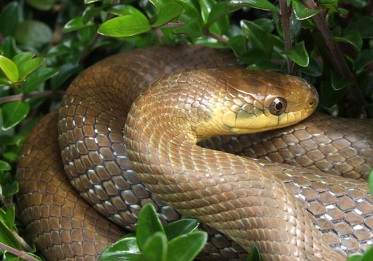 Aesculapian snakes are named after the Greek god of medicine, Aesculapius. To the Greeks snakes generally were sacred beings of wisdom, healing and resurrection, and according to myth Aesculapius learned the secrets of healing from them. He is usually depicted with a staff around which is wrapped a snake, and specifically it is the placid, nonvenomous aesculapian snake that is associated with him. Temples dedicated to Aesulapius (Asclepieia) becamed renowned centres for medicine to which pilgrims flocked to be cured of their ills. One of the most famous of these was at Epidaurus in north-eastern Peloponnese (dating from fourth century BC) where aesculapian snakes slithered around freely on the floors in the dormitories and under the beds where the sick and injured slept. They were also often used in healing rituals. 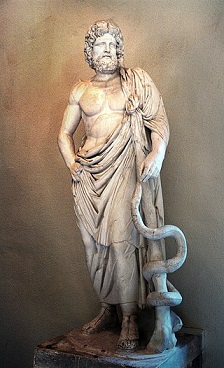 Aesculapius with his staff and snake at Epidaurus. Apart from the mythological narrative I wonder what might be the origin of the link between snakes and healing. Certainly I can see that non-venomous snakes might be good for general hygiene: they are efficient hunters of mice and rats whist also not likely to cause allergy problems (although personally I wouldn't have found it particularly restful or calming to have had them slithering around the wards). I can also see that snakes (generally) might be connected with toxicology and pharmacology as venomous snakes possess an antivenom against their own poison while some snakes have venom that contains medicinally useful anti-sepsis and anti-blood clotting agents. The staff and snake motif is still widely used throughout the world as a symbol for medicine, pharmacology and health care. 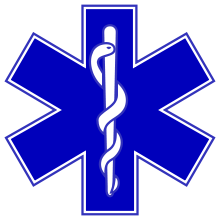 I have however noticed that there is also a distinct rod and two-snake form, the caduceus. This was the herald's staff carried by Hermes in Greek mythology and hence why the staff is often depicted as winged at the top. As a symbolic object the caduceus represents Hermes (or the Roman Mercury) and by extension it was a recognized symbol of communication, logistics, trade, commerce and negotiation, ie those realms in which balanced exchange and reciprocity are recognized as ideals. But in the US particularly, the two-snake caduceus is often used as a symbol of healthcare organizations and medical practice. How did this come about and is it simply due to confusion with the traditional medical symbol, the Rod of Asculapius? Or, given that the caduceus is a symbol of commerce, might it be a cynical reflection of professional health-care in the US? 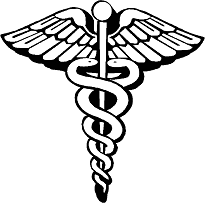 So why are snakes often associated with medicine and why does the US use the caduceus symbol while Europe generally sticks with the Aesculapian rod-and-snake?
Last edited by Meles meles on Fri 22 Oct 2021, 09:52; edited 2 times in total (Reason for editing : typos) |
|   | | Temperance
Virgo Vestalis Maxima

Posts : 6895
Join date : 2011-12-30
Location : UK
 |  Subject: Re: Aesculapius - medicine, healing and snakes Subject: Re: Aesculapius - medicine, healing and snakes  Thu 21 Oct 2021, 15:58 Thu 21 Oct 2021, 15:58 | |
| How very odd that you should introduce this topic, MM. Fascinating account, and I am very jealous of your friendly encounter with the little snake. You prompt me to offer a classic bit of Temperance mumbo-jumbo, and, in so doing, expose myself to ridicule. But what the heck. About a month ago I had a weird dream that I was carrying a bucket in which were coiled two very pretty, clearly feminine (don't know how I knew, I just did!) snakes - docile and not at all threatening or venomous. In my dream I was trying to look after - protect - these creatures, hence my refusal to put the bucket down. I was mystified by this odd dream, being aware that, in classic Freudian terms, snakes are usually a phallic symbol rather than "feminine". This dream was in no way a sexual dream, neither was it a horrible nightmare, nor was it in any way a remotely distressing one - quite the opposite in fact: it was a very serene sort of dream. It was just weird. One of my closest friends is a properly-trained psychotherapist who is an expert on Jung. She said this dream suggested healing - possibly pointing me in the direction of being a "healer". I laughed at this, saying I had no ability to "heal" anyone, and I did not "do" Reiki or anything like that - had no interest other than reading general books on psychotherapy/addiction/dealing with messed up kids. She said no more, but recommended this book - The Snake in the Clinic. It is is all about the snakes you mention, and how the Greeks revered the creatures as symbols of healing rather than the later Christian obsession with snakes as symbols of evil. I want to read the book, but it's very expensive at about £25, so have not yet bought it. Doubt if the library has it. I tried to "Look Inside" on Amazon, but the pages are limited - no joy there. I like your little snake - she looks just like the snakes (odd there were two) in my dream! The Snake in the Clinic |
|   | | Temperance
Virgo Vestalis Maxima

Posts : 6895
Join date : 2011-12-30
Location : UK
 |  Subject: Re: Aesculapius - medicine, healing and snakes Subject: Re: Aesculapius - medicine, healing and snakes  Thu 21 Oct 2021, 17:08 Thu 21 Oct 2021, 17:08 | |
| I think you are right about the significance of venom as an anti-clotting agent, but also found this snippet: Historically, serpents and snakes represent fertility or a creative life force. As snakes shed their skin through sloughing, they are symbols of rebirth, transformation, immortality, and healing. The ouroboros is a symbol of eternity and continual renewal of life.The ouroboros is a very strange symbol - the snake (or dragon) eating its own tail. The Egyptians painted them on the walls of their burial chambers and the Greeks later adopted them as a magic symbol - as did the later Western alchemists. 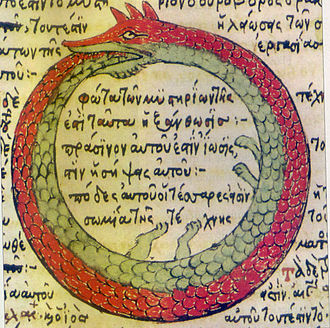
PS Odd thing is my real name is derived from Old German and means "a bright snake" which fact I found very upsetting when I was first told - who brought up in the Christian West wants to be a snake, even a "bright" one! I was reassured that it actually means "healer" rather than anything negative - still not too happy about it though! |
|   | | Vizzer
Censura

Posts : 1854
Join date : 2012-05-12
 |  Subject: Re: Aesculapius - medicine, healing and snakes Subject: Re: Aesculapius - medicine, healing and snakes  Thu 21 Oct 2021, 18:05 Thu 21 Oct 2021, 18:05 | |
| Love the story Meles. Not sure what gender the snake is but (with a nod to Temp’s dream about female snakes) the idea of Shula Yellowneck being a serpentine equivalent of the avian Robin Redbreast is sweet.
It’s unclear why the Hermesian caduceus is used in the US while the Aesculapian rod-and-snake is used in Europe but it does seem to be a case of misidentification. I note that even Res Historica uses it as the icon for the Health, medicine and care board. And I have to say that (until today) I was also unaware of the distinction or the difference. So thanks for that revelation.
When I spent a year in primary school in the Rhône department of France, woodland nature trails and picnics were a regular feature of the summer term. Once in a while the cry of “vipère!” would go up and a rush of boys and girls would head off in the direction of the offending serpent which had invariably slithered off by the time the location in question was reached. The calls from the accompanying teachers of “Ne chassez pas des serpents, les enfants! Ne quittez pas le sentier!” (“Don’t chase snakes children! Don’t leave the path!”) were generally ignored. At home that evening my mother asked me what we had been doing at school that day. “Oh, we chased vipers in the woods” I replied with hint of franglais creeping into my speech. “You mean snakes!” she said with mounting alarm. “Yes” I replied “but we didn’t catch any.” It was only later in life that I appreciated that a viper isn’t just another word for a snake but indicates a venomous one. Interestingly, the French also have the word ‘couleuvre’ for a non-venomous snake which is a term which doesn’t seem to have an equivalent in the English language as far as I know. |
|   | | Triceratops
Censura

Posts : 4377
Join date : 2012-01-05
 |  Subject: Re: Aesculapius - medicine, healing and snakes Subject: Re: Aesculapius - medicine, healing and snakes  Thu 21 Oct 2021, 19:50 Thu 21 Oct 2021, 19:50 | |
| Stories of the Old West sometimes feature the "Snake Oil Salesman" a purveyor of medicines which are claimed to cure practically every ailment under the sun. Naturally, they don't and the phrase has come to mean a conman or quack.  When "Doctor" Stanley's snake oil was examined by the US Bureau of Chemistry it was found to contain ingredients which could not cure the ailments which it supposedly could. Fined $20 for Fraud  |
|   | | Triceratops
Censura

Posts : 4377
Join date : 2012-01-05
 |  Subject: Re: Aesculapius - medicine, healing and snakes Subject: Re: Aesculapius - medicine, healing and snakes  Thu 21 Oct 2021, 20:11 Thu 21 Oct 2021, 20:11 | |
| Emperor Tiberius had a pet snake: Suetonius: Once he came in a galley as far as the gardens near the Naumachia, but placed guards along the banks of the Tiber, to keep off all who should offer to come to meet him. The second time he travelled on the Appian way, as far as the seventh mile-stone from the city, but he immediately returned, without entering it, having only taken a view of the walls at a distance. For what reason he did not disembark in his first excursion, is uncertain; but in the last, he was deterred from entering the city by a prodigy. He was in the habit of diverting himself with a snake, and upon going to feed it with his own hand, according to custom, he found it devoured by ants: from which he was advised to beware of the fury of the mob. James Mason, as Tiberius, and friend from the 1985 TV mini-series AD |
|   | | Temperance
Virgo Vestalis Maxima

Posts : 6895
Join date : 2011-12-30
Location : UK
 |  Subject: Re: Aesculapius - medicine, healing and snakes Subject: Re: Aesculapius - medicine, healing and snakes  Thu 21 Oct 2021, 20:48 Thu 21 Oct 2021, 20:48 | |
| Apparently snake oil was originally considered an efficacious remedy - even old Pliny (the Elder) was a fan!
The grease of a snake mixed with verdegreece, healeth any part of the eye that is broken: but the slough or old skin which they cast off in the spring, doth clarifie the eie-sight, if the eies bee gently rubbed therewith.
— Pliny the Elder, The historie of the vvorld (trans. by Philemon Holland), 1634
Some vse snakes grease and oil together: also a liniment made with the ashes of snakes burnt, tempered either with oil or wax.
— Pliny the Elder, The historie of the vvorld (trans. by Philemon Holland), 1634
The Oyl of Snakes and Adders. Take Snakes or Adders when they are fat, which will be in June or July, cut off their heads and take off their skins, and unbowel them, and put them into a glass gourd; and pour on so much of the pure spirit of Wine wel rectified, that it may cover them four or five fingers breadth; stop the glass wel, and set it in Balneo til all their substance be turned into an oyl, which keep wel stopt for your use. This oyl doth wonderfull cures in recovering hearing in those that be deaf, if a few drops thereof be put warm into the ears.
— John French, The art of distillation, 1653
Didn't know Tiberius had a pet snake, Trike. I wonder what it was called? Can't think what a suitable Latin name for such a patrician reptile would be.
Last edited by Temperance on Thu 21 Oct 2021, 22:07; edited 2 times in total |
|   | | Meles meles
Censura

Posts : 5122
Join date : 2011-12-30
Location : Pyrénées-Orientales, France
 |  Subject: Re: Aesculapius - medicine, healing and snakes Subject: Re: Aesculapius - medicine, healing and snakes  Thu 21 Oct 2021, 20:58 Thu 21 Oct 2021, 20:58 | |
| - Vizzer wrote:
- Interestingly, the French also have the word ‘couleuvre’ for a non-venomous snake which is a term which doesn’t seem to have an equivalent in the English language as far as I know.
I suspect that is because there are quite a few more species of snake (about twelve main species) in France, both venomous ('vipères') and non-venomous ('couleuvres'), than in the British Isles. There are really only two common snakes in the UK: the adder/viper and the grass-snake. There is also the non-venomous smooth snake, but they are very rare and found only in a few protected heathland habitants in southern England. Interestingly there are also three small isolated populations of aesculapian snakes but these are almost certainly derived from escapees. The oldest recorded population of British aesculapids is in the vicinity of the Welsh Mountain Zoo near Conwy in North Wales which have been recorded there since the 1970s. A second population lives along the Regent's Canal near London Zoo and there's a third population around Bridgend in South Wales. The London and Bridgend populations have possibly been present, largely undetected, for the past two decades. The common European viper (Vipera berus) aka the British adder, doesn't actually range as far south as the Mediterranean and so here its place is taken by the European asp (Vipera aspis) however unlike the large and fairly podgey British adder, these are slim and rarely longer than 40cm. In contrast, while my garden visitor was about a metre long, I have seen aesculapian snakes here of over two metres length. Interestingly the name 'viper' derives from the Latin vipera meaning "viper, snake, serpent," but typically venomous, and is a contraction of vivipera, from vivus meaning "alive, living" because most vipers do not lay eggs but rather give birth to live young. Meanwhile the name 'couleuvre' derives from the Latin colubra again meaning "a snake", but typically non-venomous, however interestingly it also forms the etymological origin for the highly venomous cobra. In English there is the term colubrid, meaning the family of (almost entirely) non-venomous snakes that includes the common grass-snake, smooth snake, aesculapid snake etc. but that is a rather specific scientific term. |
|   | | Green George
Censura

Posts : 805
Join date : 2018-10-19
Location : Kingdom of Mercia
 |  Subject: Re: Aesculapius - medicine, healing and snakes Subject: Re: Aesculapius - medicine, healing and snakes  Thu 21 Oct 2021, 23:31 Thu 21 Oct 2021, 23:31 | |
| |
|   | | Meles meles
Censura

Posts : 5122
Join date : 2011-12-30
Location : Pyrénées-Orientales, France
 |  Subject: Re: Aesculapius - medicine, healing and snakes Subject: Re: Aesculapius - medicine, healing and snakes  Fri 22 Oct 2021, 09:14 Fri 22 Oct 2021, 09:14 | |
| In that extract from the Gilgamesh epic there are echos of a another myth concerning Aesculapius. Asculapius was commanded by Zeus to restore the life of Glaucus and while lost in thought pondering on what he should do, he accidentally killed a snake with his staff. Another snake then came with a herb in its mouth, which it placed on the head of dead snake, promptly bring it back to life. Seeing this Asculapius used the same herb to revive Glaucus, who thereafter was immortal. I'm rather ignorant about all this ancient mythology but it seems that Hermes' entwined two-snake caduceus symbol also has its origins in ancient Sumerian mythology being the symbol of the god Ningishzida, the deity of plants, agriculture and the underworld, and who was also particularly associated with the three mythical horned snake/dragon/gryphon creatures, mushussu, ushumgal and bashmu. 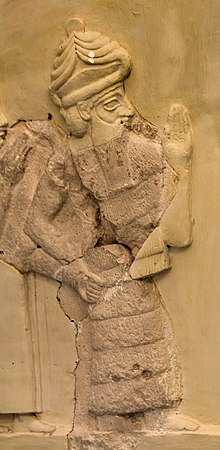 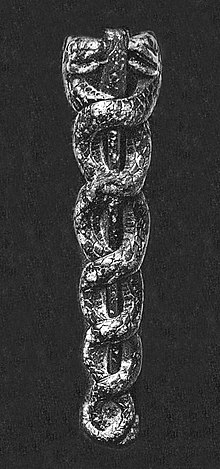 Left: The Sumerian god Ningishzida, with snakes emanating from his shoulders, on a relief of Gudea, c. 2000 BCE. Right: The Caduceus, symbol of Ningishzida, on the libation vase of Sumerian ruler Gudea, c. 2100 BCE. In ancient Egyptian religion there was also the cobra-headed goddess Wadjet, the protector of Lower Egypt, who was sometimes depicted as a snake twining up a papyrus stem, staff or pole. 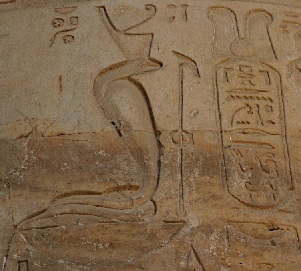 Relief of Wadjet, as a cobra wearing with the Deshret or Red Crown of Lower Egypt, in the Temple of Horus in Edfu. |
|   | | Meles meles
Censura

Posts : 5122
Join date : 2011-12-30
Location : Pyrénées-Orientales, France
 |  Subject: Re: Aesculapius - medicine, healing and snakes Subject: Re: Aesculapius - medicine, healing and snakes  Mon 08 Nov 2021, 10:29 Mon 08 Nov 2021, 10:29 | |
| I think I've worked out why the two-snake Caduceus, rather than the one-snake Rod of Aesculapius, is often the symbol for medical-care providers in the US. The caduceus, as the staff of Hermes (or rather his reincarnation during the Egyptian-Ptolemaic period as Hermes Trismegistus) became associated with alchemy and thus eventually with pharmacy. However in Britain at least, the distinction between the rod of Asclepius (medicine and healing) and the caduceus of Hermes (pharmacy, communication and trade), as symbols for different professions was apparently still quite clear into the 19th century. In his article 'On Tradesmen's Signs of London' (Journal of the British Archaeological Association, April, 1853) A.H. Burkitt noted that among the very old symbols still used in London at that time, "we find Mercury, or his caduceus, appropriate in trade, as indicating expedition. Esculapius, his Serpent and staff, or his cock, for professors of the healing art".Widespread confusion regarding the supposed medical significance of the caduceus seems to have arisen from events in the United States in the second half of the 19th century, although originally this may well have been due to deliberate choice rather than simple misunderstanding. The caduceus had appeared on the chevrons of US Army hospital stewards as early as the 1850s, however hospital stewards were not physicians: they played a supporting role preparing drugs for surgeons, supervising nurses and cooks and maintaining accounting and medical records. So it could be argued that the caduceus, representing pharmacy, business and communication, was indeed the better symbol. Perhaps from this existing hospital usage, or from the caduceus' relationship with trade, seamen and the maritime industry, the caduceus was designated the insignia of the Marine Hospital Service in 1871 by the first the Surgeon General of the United States, John Maynard Woodworth, who also adopted it as the seal of the office of US Surgeon General. In 1912 the Marine Hospital Service became the US Public Health Service.  The caduceus was formally adopted by the Medical Department of the United States Army in 1902 and was added to the uniforms of Army medical officers. At the time a number of medical officers were unhappy with the choice, no doubt recognising that the rod of Aesculapius was the better symbol. The 'Army and Navy Register' of June 1902 discussed the argument and the editor claimed that the symbol had not been chosen for its medical connotations and proposed the following symbolic interpretation: "the rod represents power, the serpents stand for wisdom and the two wings imply diligence and activity, qualities which are undoubtedly possessed by our Medical officers." The editor also pointed out that, as with the US Hospital Service, the majority of Medical Corps personnel were not even doctors, and so according to this line of reasoning, the caduceus was never intended to be a symbol of medicine. 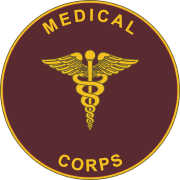 Badge of the US Army Medical Corps, 1902. The Army Medical Corps, having popularised the caduceus and while retaining the caduceus for its own insignia, is now part of the Army Medical Department, which has since adopted the Rod of Aesculapius as its main symbol. Furthermore when the US Air Force designed new medical insignia it also adopted the Rod of Aesculapius, perhaps to avoid confusion between the winged caduceus uniform insignia of Air Force medical staff and the the eagle-winged badges of flying crewmen.  Current ensign of the US Army Medical Department. Even the American Medical Association used the caduceus symbol for a time, but in 1912, after considerable discussion, the caduceus was abandoned by the AMA and the rod of Aesculapius was adopted instead. 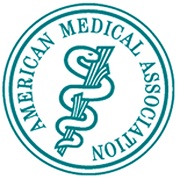 However the two-snake caduceus is still widely used by many hospitals, medical schools, healthcare associations and medical practices. And given that a lot of American medicine is driven by commercialism, perhaps the two-snake caduceus - the representative of Hermes the herald, communication, travellers, trade, merchants and commercial enterprise, and little to do with healing and health care, unless at a price - is actually the more appropriate symbol.
Last edited by Meles meles on Tue 09 Nov 2021, 10:24; edited 1 time in total |
|   | | Green George
Censura

Posts : 805
Join date : 2018-10-19
Location : Kingdom of Mercia
 |  Subject: Re: Aesculapius - medicine, healing and snakes Subject: Re: Aesculapius - medicine, healing and snakes  Mon 08 Nov 2021, 13:52 Mon 08 Nov 2021, 13:52 | |
| Wasn't Hermes the god of thieves? might make him appropriate for American medicine. |
|   | | Triceratops
Censura

Posts : 4377
Join date : 2012-01-05
 |  Subject: Re: Aesculapius - medicine, healing and snakes Subject: Re: Aesculapius - medicine, healing and snakes  Mon 08 Nov 2021, 14:16 Mon 08 Nov 2021, 14:16 | |
| From the Urban Dictionary.
A Wallet Biopsy involves an inquiry similar to that of the regular biopsy noted above except that in the wallet biopsy the goal is to determine the ability of the patient to pay for the medical care which the doctor might recommend.The results of the wallet biopsy will reveal the nature and extent of the patient's health insurance coverage and/or the extent of the patient's personal wealth so that the doctor will know whether or not the patient can afford to pay the freight for the procedure. |
|   | | Meles meles
Censura

Posts : 5122
Join date : 2011-12-30
Location : Pyrénées-Orientales, France
 |  Subject: Re: Aesculapius - medicine, healing and snakes Subject: Re: Aesculapius - medicine, healing and snakes  Thu 23 May 2024, 09:52 Thu 23 May 2024, 09:52 | |
| Yesterday I almost stumbled over another large aesculapian snake that had lazily draped its five foot length across my garden path and well into the flower borders at either end, and which was sunning itself barely ten feet from where I'd had the snakey meeting with which I'd opened this thread. Once I'd recovered from the initial surprise (as well as the sudden clenching of my back muscles that I always get whenever I unexpectedly meet a snake, presumably in an automatic fight-or-flight response) I left it well alone since it likely had only very recently come out of hibernation and didn't seem particularly keen to vacate its place in the sun ... and because I'm a bit of a wimp where snakes are concerned. This encounter did however bring to mind a recent photo feature in The Guardian about the Snake Festival of Cocullo (Festa dei Serpari di Cocullo) held annually on the 1st May when the snakes are starting to become active as the weather warms up. Cocullo is a village in the Abruzzo region of Italy and the snake festival honours St. Dominic di Sora the patron saint of the village who is also locally invoked for protection against snakebite and, slightly bizarrely until you think about it, tooth-ache. During the festival, Serpari, a hereditary brotherhood of local snake-charmers/snake-catchers, scour the local countryside for snakes which are then carried through the streets in procession draped over a statue of the saint. It's also an opportunity for biologists to monitor the state of the snake population by recording the relative numbers caught and the health of individual animals before they are all released at the end of the day. The snakes are all non-venomous and fairly placid species (mainly four-lined, aesculapian, grass and green whip snakes) nevertheless as you'll have gathered I'm not very keen on snakes, though I'd never harm them, so it's not an event I'm ever likely to attend. The village's association with snakes is very old with the medieval coat of arms showing two snakes twining up a broken stone column and looking very similar to the caduceus symbol mentioned above.  However the festival, whilst now dedicated to a catholic saint, appears to have pre-Christian roots related to the ancient rite of the Roman snake deity, Angitia, who had a sanctuary nearby which was, much like with the cult of Aesculapius in Greece, a place of healing.   I wonder how the modern snake-charmers manage to get the snakes to stay put on the saint's statue as it is carried through the streets. Maybe, like the ancient priests of Angita, they can exert a magicial control over the reptiles ... or perhaps, like with my own snakey encounter, they simply rely on them still being a bit sluggish at this time of year. |
|   | | LadyinRetirement
Censura

Posts : 3328
Join date : 2013-09-16
Location : North-West Midlands, England
 |  Subject: Re: Aesculapius - medicine, healing and snakes Subject: Re: Aesculapius - medicine, healing and snakes  Sat 25 May 2024, 13:59 Sat 25 May 2024, 13:59 | |
| Anything to help a broken femur, MM? I know, I know, I should have waited till it was light to put my rubbish out. If we learn by our mistakes maybe I should be more learned than I am. I'm switching my phone off much of the time so as to save the "juice" but hopefully can rejoin you on Res Hist when I'm discharged from hospital |
|   | | Meles meles
Censura

Posts : 5122
Join date : 2011-12-30
Location : Pyrénées-Orientales, France
 |  Subject: Re: Aesculapius - medicine, healing and snakes Subject: Re: Aesculapius - medicine, healing and snakes  Sun 26 May 2024, 09:42 Sun 26 May 2024, 09:42 | |
| A broken femur, LiR, that sounds very serious. And didn't you break your wrist last year too? I'd willingly send you my own 'healing' snake of aesculapias: she was there again this morning, flopped across the path in the early morning sun (I worry where she hides during the day and worry more where she might go to at night, especially in summer when I generally sleep with the windows and kitchen door open). However I doubt you'd be very keen on that and unless she could miraculously turn into a handy solid walking stick, like Aaron's Staff, probably not much practical use either. Seriously though I sincerely hope you get all the support and help possible, and that you get back on your feet soon. Here's wishing you all the very best for a speedy recovery. |
|   | | Vizzer
Censura

Posts : 1854
Join date : 2012-05-12
 |  Subject: Re: Aesculapius - medicine, healing and snakes Subject: Re: Aesculapius - medicine, healing and snakes  Sun 26 May 2024, 14:31 Sun 26 May 2024, 14:31 | |
| As you no doubt know LiR, people recovering from broken bones are often prescribed a course of anti-coagulant medication (normally in the form of an injection) from the heparin family of medicines such as enoxaparin. Originally detected in the liver of mammals during the First World War its crucial component is an amino sugar which can also be derived from reptiles.
Another source of anti-coagulant (although not used in heparin) is snake venom. Some vipers immobilise their prey by thinning its blood while others do the opposite by causing the blood to clot. Both of these characteristics have found use in the development of medicines not only from the venom of snakes but also from that of spiders, scorpions, bees, wasps, ants and even some snails etc. This has been known (and practiced with varying results) in many cultures for millennia although the practical application of venom-derived treatments in Western medicine has only been realised during the last 40 years.
Whether one’s invoking St Dominic or St Patrick or Angitia or another, however, I’ll join Meles is hoping that you’ll be back on your feet soon. |
|   | | LadyinRetirement
Censura

Posts : 3328
Join date : 2013-09-16
Location : North-West Midlands, England
 |  Subject: Re: Aesculapius - medicine, healing and snakes Subject: Re: Aesculapius - medicine, healing and snakes  Sun 26 May 2024, 18:40 Sun 26 May 2024, 18:40 | |
| Thanks Meles and Vizzer. I was on morphine but that's been stopped because aa doctor thought it might be causing confusion - I tried to get out of bed when I came out from the anaesthetic as I thought I was at home. I've been moved to a general orthopaedic ward now. I've done a little walking to the loo etc with a walker. It does hurt but it's just baby steps. Thanks for kind wishes. |
|   | | Sponsored content
 |  Subject: Re: Aesculapius - medicine, healing and snakes Subject: Re: Aesculapius - medicine, healing and snakes  | |
| |
|   | | | | Aesculapius - medicine, healing and snakes |    |
|
Similar topics |  |
|
| | Permissions in this forum: | You cannot reply to topics in this forum
| |
| |
| |
